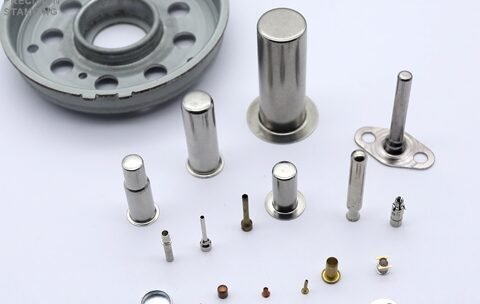Micro deep draw stamping, a specialized technique in the manufacturing realm, has revolutionized the production of high-precision, thin-walled components. But what exactly is this technology, and how does it stand out? Let’s delve into its intricacies.
Micro deep draw stamping, facilitated by progressive dies, is a process predominantly employed to fabricate high-precision, thin-walled parts.
To grasp the full potential and nuances of this technology, let’s explore its core principles, advantages, and applications.

Fundamentals of Micro Deep Draw Stamping
In the vast landscape of metalworking, certain techniques stand out for their precision and ability to produce intricate parts. Micro deep draw stamping is one such method, offering unparalleled accuracy for thin-walled components. Let’s explore the core of this technology.
What is Micro Deep Draw Stamping?
Micro deep draw stamping is a specialized metal forming process used to create deep, intricate, and thin-walled parts from sheet metal. Unlike traditional stamping, which focuses on broader and shallower shapes, micro deep draw stamping delves deeper, often producing parts with a depth more than four times their diameter. This process is particularly significant in industries where precision is paramount, such as medical, electronics, and aerospace. The “micro” in its name emphasizes the technique’s ability to produce minute components, often smaller than a coin, with impeccable accuracy.
Role of Progressive Dies
Progressive dies play a pivotal role in the micro deep draw stamping process. These are a set of dies arranged in a sequence, allowing the metal sheet to undergo multiple operations in a single pass. As the sheet metal progresses through the die set, it undergoes various stages of forming, from initial shaping to final trimming. This sequential approach ensures consistent and high-quality parts, making the process efficient and suitable for mass production. The precision of progressive dies, combined with their ability to produce complex shapes in a single pass, makes them indispensable in the realm of micro deep draw stamping.

Advantages of Micro Deep Draw Stamping
Micro deep draw stamping, with its specialized techniques and tools, offers a plethora of advantages over traditional metalworking methods. These benefits not only enhance the quality of the final product but also contribute to cost savings and production efficiency.
Precision and Consistency
One of the standout advantages of micro deep draw stamping is its unparalleled precision. The process, facilitated by meticulously designed progressive dies, ensures that each part produced mirrors its predecessor in terms of dimensions and quality. This repeatability is crucial, especially in industries like aerospace or medical devices, where even the slightest deviation can have significant implications. With micro deep draw stamping, manufacturers can rest assured that every component, from the first to the thousandth, meets the exact specifications.
Material Efficiency
Wastage is a concern in any manufacturing process. However, micro deep draw stamping stands out for its material efficiency. The process is designed to utilize sheet metal optimally, ensuring minimal wastage. This not only translates to cost savings but also aligns with sustainable manufacturing practices. By reducing scrap and optimizing material usage, manufacturers can achieve a balance between production efficiency and environmental responsibility.
Speed and Scalability
In the fast-paced world of manufacturing, time is of the essence. Micro deep draw stamping, with its progressive die system, allows for the rapid production of parts. Since multiple operations are performed in a single pass, the process is significantly faster than traditional methods. This speed doesn’t compromise on quality, making it ideal for mass production. Whether a manufacturer needs a few hundred parts or several thousand, micro deep draw stamping scales seamlessly to meet the demand, ensuring timely delivery without sacrificing precision.

Applications of Micro Deep Draw Stamping
The precision and efficiency of micro deep draw stamping have made it a sought-after technique in various industries. Its ability to produce intricate, thin-walled components with impeccable accuracy has led to its adoption in sectors where precision is paramount. Let’s delve into some of the key applications of this technology.
Medical Devices
The medical industry, with its stringent standards and need for high precision, greatly benefits from micro deep draw stamping. From surgical instruments to implantable devices, the process is instrumental in producing components that are both intricate and reliable. For instance, parts for hearing aids, dental tools, and even components for minimally invasive surgical procedures are often crafted using this method. The repeatability and precision of micro deep draw stamping ensure that these medical devices function consistently, a critical factor in patient care and safety.
Electronics
As electronic devices become smaller and more sophisticated, the demand for miniature components has surged. Micro deep draw stamping rises to the challenge, aiding in the fabrication of parts like connectors, casings, and even micro-switches. These components, often smaller than a grain of rice, are integral to the functioning of devices like smartphones, tablets, and wearables. The process ensures that these parts are produced with the highest precision, ensuring the reliability and longevity of electronic devices.
Aerospace and Defense
In the realm of aerospace and defense, there’s no room for error. Components need to withstand extreme conditions while maintaining their functionality. Micro deep draw stamping plays a pivotal role in producing parts for aircraft engines, navigation systems, and even satellite components. The high precision and consistency of the process ensure that these components meet the rigorous standards of the aerospace industry. Whether it’s a part for a commercial airliner or a component for a defense missile system, micro deep draw stamping ensures it’s crafted to perfection.

Challenges and Considerations
While micro deep draw stamping offers a plethora of advantages, it’s not without its challenges. Understanding these challenges and considerations is crucial for manufacturers to optimize the process and ensure the highest quality output.
Material Selection
Choosing the right material is paramount in micro deep draw stamping. The material’s ductility, tensile strength, and thickness play a significant role in determining the success of the stamping process. Materials that are too brittle may crack during stamping, while those too malleable might not retain the desired shape. Manufacturers must also consider factors like corrosion resistance, thermal properties, and cost when selecting a material. Ensuring compatibility between the chosen material and the intended application is vital for the longevity and functionality of the stamped part.
Tool Wear and Maintenance
The precision of micro deep draw stamping relies heavily on the condition of the dies used. Over time, these dies can wear out, leading to inconsistencies in the stamped parts. Regular maintenance and periodic replacement of dies are essential to maintain the quality of the output. Additionally, the use of lubricants can reduce friction and wear, prolonging the life of the dies. Manufacturers must strike a balance between maintenance costs and production efficiency to optimize the stamping process.
Design Limitations
While micro deep draw stamping is versatile, it does have its design constraints. The depth-to-diameter ratio of the stamped part is a critical consideration. If a design demands a depth much greater than the diameter, the risk of defects like wrinkling or tearing increases. Additionally, highly intricate or complex designs might pose challenges in terms of die design and stamping accuracy. Manufacturers must work closely with design teams to ensure that the intended design is feasible and can be accurately replicated through the stamping process.

Conclusion
Micro deep draw stamping stands as a testament to the advancements in modern manufacturing techniques. Its ability to produce intricate, high-precision components has revolutionized industries ranging from medical to aerospace. The process, with its emphasis on accuracy and repeatability, ensures that even the most minute components are crafted to perfection.
However, like any manufacturing method, it comes with its set of challenges. From material selection to tool maintenance, manufacturers must navigate these considerations to harness the full potential of the process. Despite these challenges, the benefits of micro deep draw stamping — from material efficiency to scalability — are undeniable.
As industries continue to evolve and demand even more precision and efficiency, micro deep draw stamping will undoubtedly play an even more significant role. Its transformative impact on manufacturing is a testament to its prowess, and its applications across various sectors underscore its versatility and potential.
In wrapping up, micro deep draw stamping is not just a process; it’s a reflection of the relentless pursuit of perfection in manufacturing, driving industries forward and setting new benchmarks in precision and quality.



